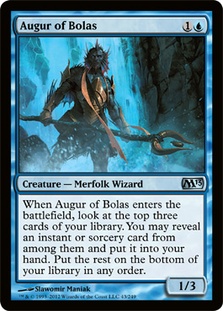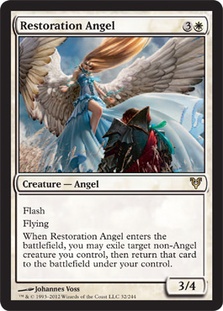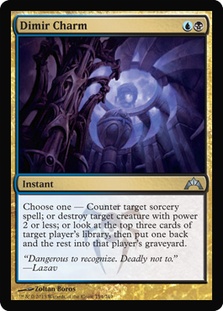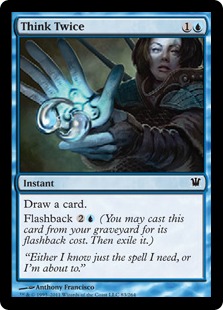My last article was a preparation article for Grand Prix Charlotte. I remember sitting in my room writing it as I watched the coverage of Pro Tour Gatecrash. As I watched, I realized how much I would’ve liked to have been there playing with the best. However, instead of dwelling on it, the productive route to take was to focus on improving my game as a whole. So I decided to try to work on my game and improve as a player.
The first step I took was to think about the upcoming tournaments I wanted to practice for. The next big events I knew of that I could go to were SCG Open Series: Washington, DC and Grand Prix Pittsburgh. Since the Open Series was first, I figured I’d focus of Standard and Legacy for the time being.
Standard
Pro Tour Gatecrash played a big role in determining the Standard metagame, but I knew before #SCGDC there would be a couple of Standard GPs and other Standard Opens. I was also qualified for the MOCS on Magic online, for which the format was Standard. I knew after looking at the Pro Tour decks that I wanted to play some version of Esper. I figured I would build a version that would be both good for the metagame and good in general. I thought the best approach would be to build the deck and then run it in some two-man and eight-man Standard queues.
The original deck I built was very unfocused. It had Lingering Souls; Sorin, Lord of Innistrad; Augur of Bolas; Nephalia Drownyard; Sphinx’s Revelation; and Tamiyo, the Moon Sage. Although these cards are all very powerful, there was no synergy, and they did not mesh well together.
The deck did fine in a few queues, but my wins were all close games and my losses were just blowouts. I didn’t have nearly enough instants and sorceries for Augur of Bolas, which made him into a two-mana 1/3 do-nothing. I was also tapping out every turn for planeswalkers or Lingering Souls, which made Dissipate comically bad. Another problem that I came across was actually winning the game. Why did I have Nephalia Drownyard when I had so many other win conditions? Was I trying to kill them with damage, decking, or both? Things didn’t seem right with my list, but I was stubborn. I even ignored advice from friends whose opinions I would normally respect and listen to (Eric Kreiter).
The MOCS rolled around, and I did awful, putting up a 4-4 record. I remembered hearing about how Reid Duke wrote down all of his play mistakes during the Players Championship so he would be able to go over them afterwards. For myself and this tournament, it was different; I’m sure I made some misplays, but my big mistake here was being narrow-minded and not open to other suggestions about my deck.
After the MOCS, I wanted learn from my mistakes and continued preparing for SCG Open Series: Washington, DC. After the tournament was officially over, I watched the replays of some of the players that had done well and saw that" LittleDarwin" (aka Paul Rietzel) made his second straight MOCS Top 8 and did so by going 8-0 in the Swiss. Impressed and intrigued to see what he had played, I quickly opened up some of his games and started to watch. After a few turns, it became clear that he was on Esper as well, but instead of a clunky build like mine, his looked very smooth and well-tuned.
Now, there was probably a time in my Magic career where I would have just thought, "Whatever, my deck is probably just as good and I just got unlucky," but that is a really bad way to look at things. Paul is a phenomenal player and a future Hall of Famer, so instead of being narrow minded and stuck on my list, I decided to reach out to Paul to hear his thoughts on Esper. Paul messaged me back a bit later and shipped me not only his list but his thoughts on Esper in general and how he thought it should be built. Here is the list Paul played in the MOCS:
Creatures (7)
Lands (27)
Spells (26)

After going over the list, there were many things I liked about it and a few things that I didn’t. I was determined to rework my original list of Esper with the new ideas Paul had given me.
After testing the deck on Magic Online and bringing it to a 2K Standard tournament, I finally felt comfortable with a list I liked. Now, before I post the list and talk about some of my card choices, I would like to touch upon a few additional points about preparing for an event and choosing a deck.
One of the most important factors to put yourself in a good position to do well is fully knowing all the ins and outs of your deck and having a deck that fits your play style. I personally very rarely play combo decks because I like to interact with my opponent and try to disrupt their game plan rather than just focusing on my own. Once you know the style of deck you want to play, the best way to practice is to play as much as you can but also get real tournament practice. Many people say tournament practice is probably the best type of practice with your deck, and I pretty much agree. Another thing that is very important to do is to stay up on the metagame; this can be done by watching SCGLive, reading articles, or scouring the deck database on StarCityGames.com.
Here is the list I will be playing in DC (with the possibility of a few small changes):
Creatures (8)
Planeswalkers (2)
Lands (26)
Spells (24)

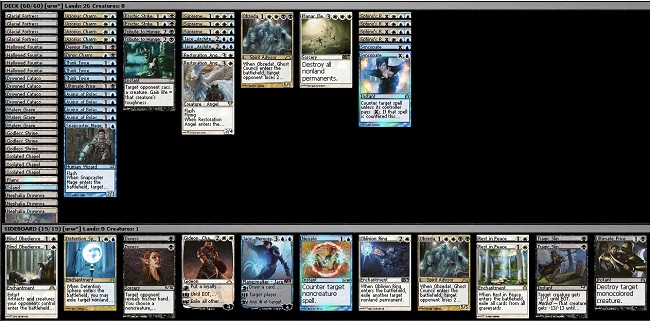
I included a visual of the deck so you can see its curve. As you can see, this deck is somewhat similar to the one Paul played. I came up with it after hours of practice on Magic Online, playing a semi-high-level Standard event, looking over the metagame, and following the GP/SCGLive coverage.
Those of you who are attending #SCGDC probably already have your deck picked out, but for the ones that don’t or for those who aren’t attending and would like to hear my thoughts behind the list, here they are.
Creatures
4 Augur of Bolas – Augur is one of the most important engines in the deck. It is obviously very important to have a high instant/sorcery count; this deck features 24 instants and sorceries so you are less likely to whiff on your Augurs. Ideally, I would have 25 or even 26 like Paul had, but Jace, Architect of Thought has been so good for me that I couldn’t see cutting him or any of the creatures to increase the instant/sorcery count.
One mistake that I came across while playing was casting Augur on turn 2 against non-aggressive decks. It is much better to play a turn 2 Think Twice or cycle an Azorius Charm to make sure you hit your land drops. Although Augur is crucial to the deck, often I will side him out when I plan to bring in additional planeswalkers, enchantments, or the second Obzedat. Augur really shines against most of the creatures decks except for U/W/R since after board your spell count decreases a fair amount.
2 Restoration Angel – Restoration Angel is one of the most flexible creatures currently in Standard. It can help fight off planeswalkers, it can gain extra card advantage from an Augur or Snapcaster, and it can act as a removal spell by jumping in front of an attacker. Although this list only plays two copies of Restoration Angel, your opponent might not be aware of this, and just the threat of the Angel could make your opponent play differently.
1 Obzedat, Ghost Council – Obzedat has been great for me because it is a hard to deal with threat against most decks, specifically U/W/R. It’s also solid against aggressive decks since you are able to not only gain life but also have a solid blocker.
1 Snapcaster Mage – The one Snapcaster Mage acts as an extra copy of many spells. Without access to Ponder or Preordain, Snapcaster is basically a four-drop, which you already have many of. One is definitely good, but you don’t want to have too many of him. You can get some extra use from Snapcaster with the two copies of Restoration Angel. Overall, I’ve been happy with one Snapcaster Mage.
Planeswalkers
2 Jace, Architect of Thought – Jace is awesome; I really can’t stress it enough! When Jace first came out, he was super hyped up; after a few days, he was put on the backburner. Then he was good again, and then he wasn’t. In this deck with lots of early counters and cheap removal spells, playing a Jace onto an empty board can be game winning. Versus aggressive creature decks, his +1 ability is super powerful, and against control decks, it’s a great way to pull ahead on cards.
The other great thing about Jace is that he only costs four mana, which can often surprise your opponent and catch them off guard. Turning off cards such as Lingering Souls and Assemble the Legions is very important as well. Overall, you want to do almost anything you can to keep him around because the longer the game goes with Jace on your side, the better chance you have to pull ahead and close out the game.
Counters
2 Psychic Strike – Although it is a control deck, this build doesn’t want play many counterspells. The Psychic Strikes are nice because they act as your hard counters. I decided to run them over Dissipate since they’re easier on the mana and the milling of two cards can come up in tight games when you are trying to deck them. Being able to Dissipate an Unburial Rites or Lingering Souls is obviously nice, but overall I like Psychic Strike as the hard counter in the deck.
2 Syncopate – Syncopate is nice because being able to interact with your opponent on turn 2 on the play and turn 3 on the draw is very important. Stopping a Farseek, Burning-Tree Emissary, or Geist of Saint Traft can be game winning, and most of the time Psychic Strike will be too slow for that to happen. Other times, Syncopate will be a surprise, and your opponent might even start to play around it when you don’t have it, which could be nice.
1 Dimir Charm – Dimir Charm isn’t really a counterspell, it isn’t really a removal spell, and isn’t really a card draw spell, but I still like it. Stopping Farseek, Rakdos’s Return, Mizzium Mortars, or a Bonfire of the Damned can change the outcome of a game. Sure, Negate would do the same thing counter-wise, but Dimir Charm gives you more options, which I really like. I wouldn’t play more than one because it’s not a super powerful card, but playing one will give you the flexibility to let it shine.
Removal
1 Ultimate Price, 4 Azorius Charm, 1 Planar Cleansing, 1 Devour Flesh, 2 Tribute to Hunger, 3 Supreme Verdict
Since there are so many different creatures in the format, having a diverse removal package is what will most likely give you the best chance to win. Cheap removal spells like Ultimate Price, Azorius Charm, Devour Flesh, and Tribute to Hunger are what you need to keep up with fast creature decks. Then, when the board gets out of hand, hopefully you have a Supreme Verdict to clear the board to catch back up and take over the game.
The Planar Cleansing often shines against more midrange decks that might have planeswalkers since six mana is usually way too slow against really fast decks like Naya Blitz. Overall, I like this package the best since it works nicely with Augur of Bolas as you are sometimes able to select the removal spell you need in certain scenarios (but really, if you get any card with Augur, you should be happy).
Card Draw
4 Sphinx’s Revelation, 3 Think Twice
Even though I only listed seven cards in this category, you have many more. Azorius Charm, Augur of Bolas, Jace, and Snapcaster Mage all work as some form of card draw.
Lands
I decide to go with 26 lands; three of them are Nephalia Drownyard. Originally, I had 27, but I found that to be a bit too many at times, and with the cheap card draw, you can often find the lands you need to avoid missing land drops. As far as the number of shocklands, M10 lands, and basics, I just tried to make it as balanced as I could; it’s pretty close to standard.
Sideboard
1 Jace, Memory Adept; U/W/R, Control, Bant, Human Reanimator with Rest in Peace
1 Detention Sphere: Planeswalkers, Aggressive Decks
1 Obzedat, Ghost Council: U/W/R, Naya Blitz, Control Decks
2 Blind Obedience: Mono-Red Aggro, Naya Blitz, Aggro
2 Duress: Control, U/W/R, Jund
2 Rest in Peace: Reanimator, U/W/R
1 Oblivion Ring: Planeswalkers, Aggressive Decks
1 Ultimate Price: Aggro, U/W/R, Bant
1 Negate: U/W/R, Control, Reanimator, Jund
2 Tragic Slip: Aggro
1 Gideon, Champion of Justice: Control, Bant, U/W/R
Legacy
An awesome thing about the SCG Open Series is that you usually get the opportunity to play both Standard and Legacy. However, it can be difficult to extensively prepare for both events. For the Legacy portion of #SCGDC, I decided the best deck would be something that I’m both familiar with and comfortable playing. After thinking about my options, I’ve come to the conclusion that Jund is the best choice for me.
The steps I took to make this decision are as follows. First, I looked at the results from the past two Legacy Opens. I then decided that Jund would be good for the current metagame. It has disruption spells and solid threats, which is a powerful combination for success. After deciding that I wanted to play Jund, I then searched for articles about it and increased my overall knowledge about the archetype. Since Legacy has so many decks, knowing the ins and outs of your deck is often more important than having a good matchup against a certain archetype because you never know what you’re going to play against. After reading this article by Reid Duke, I decided to use his list as a starting point for mine.
Here is the list that I plan on running:
Creatures (16)
Planeswalkers (4)
Lands (23)
Spells (17)
- 3 Lightning Bolt
- 3 Hymn to Tourach
- 1 Sylvan Library
- 1 Life from the Loam
- 4 Thoughtseize
- 1 Maelstrom Pulse
- 1 Inquisition of Kozilek
- 3 Abrupt Decay
Sideboard

In conclusion, I hope this article gave you some insight into how I prepare for upcoming Constructed events. If you plan on going to SCG Open Series: Washington, DC, stop by and say what’s up. If you end up playing the Esper deck, let me know how you do, and if you guys have any questions about it, you can ask me in the comments or follow me @Gfabs5 on Twitter.
Thanks for reading!

